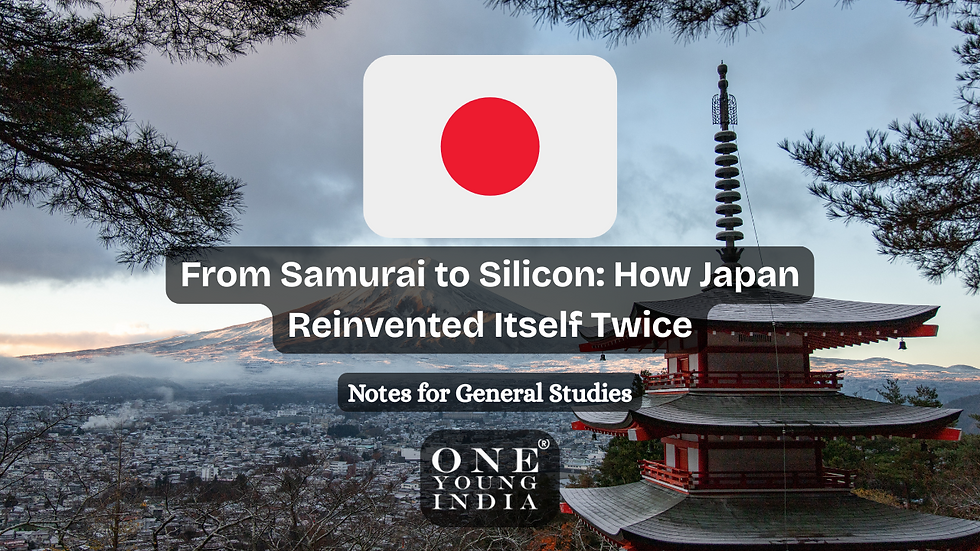What Is Art For?
- One Young India

- Aug 1
- 4 min read
Imagine walking into a dimly lit gallery. A painting on the far wall stops you in your tracks. It’s nothing you’ve seen before. Maybe it’s grotesque. Maybe it’s breathtakingly beautiful. Either way, you feel something. A nudge in the chest. A pause in thought. For a brief moment, you’re outside the noise of everyday life. You’re face-to-face with something raw, wordless, and powerful.

That is art.
But what is art for? Why does it exist? And why does it endure?
Let’s explore.
1. Art Is Older Than Civilization
1.1 The First Artists
Long before agriculture, empires, or alphabets, humans created art. The cave paintings at Lascaux, France—dating back 17,000 years—depict galloping horses, deer, and human symbols. The Löwenmensch (“Lion-Man”) sculpture from Ice Age Germany, carved over 40,000 years ago, merges human and animal in a vision of myth and imagination.
These weren't random doodles. They were deliberate, sacred, storytelling.
1.2 Art as a Human Instinct
Art didn't arise as a luxury—it emerged as a necessity. It was a tool for meaning, memory, and identity. Before gods, laws, and borders, there was art.
2. Art as Communication
2.1 Beyond Words
Art speaks when words fall short. A painting, a melody, a dance—these convey feeling, memory, or trauma when language cannot. This is why art is so often used to express grief, love, confusion, and wonder.
2.2 Timeless Dialogue
A novel from the 19th century, a tribal chant passed down generations, or a sculpture from an ancient civilization—they all carry messages across time. Art connects us to people we've never met, from places we’ve never been.
3. Art as Meaning-Maker
3.1 Art Helps Us Make Sense of Life
Humans are meaning-seeking beings. We don’t just exist—we interpret. Art helps us grapple with life’s deepest questions:
Who are we?
Why do we suffer?
What does it mean to be free?
3.2 The Role of Myth, Religion, and Story
From the stained glass windows of cathedrals to the vibrant depictions of Hindu gods, art has long been a vehicle for spiritual and cultural expression. It makes the intangible visible. It transforms beliefs into images, rituals, and symbols.
4. Art as Mirror and Critic
4.1 Reflection and Criticism
Art not only reflects society—it critiques it. Whether subtle or overt, art challenges the status quo.
Picasso’s Guernica is not just a painting. It’s a protest against war. George Orwell’s 1984 is not just fiction. It’s a warning.
4.2 The Threat of Art to Power
Dictators fear art because it awakens people. Censorship, book burnings, and bans are not about fear of ink or paint—they are fear of what art can do. Art can be rebellion dressed as beauty.
5. Art as Healing
5.1 Emotional First Aid
Art has the power to soothe wounds that medicine cannot reach. When people suffer—whether from trauma, illness, or isolation—they often turn to art.
A poem can give voice to pain. A painting can externalize grief. A song can offer the catharsis of tears.
5.2 Art Therapy and Science
Art therapy is now a legitimate clinical tool. Studies in neuroscience show that engaging with art activates dopamine pathways, reducing anxiety and increasing joy. It’s not just emotional—it’s biological.
6. Art as Connection
6.1 Shared Experience
In an era of hyper-personalized feeds and cultural fragmentation, art remains a rare unifier. A concert, film, or play gathers strangers into a common emotional journey.
6.2 Global and Timeless Bonds
Art builds bridges across cultures and eras. An ancient Chinese poem can move a modern American. An African mask can inspire a European sculptor. It collapses distance and time.
7. Art as “Useless”—and Why That Matters
7.1 The Paradox of Usefulness
Oscar Wilde once said, “All art is quite useless.” It was a provocation—and a truth. In a utilitarian world where everything must have a function, art dares to just be.
It asks us to pause. Reflect. Feel.
7.2 Art as Sacred Leisure
Art resists efficiency. A painting doesn't feed you, a sculpture doesn’t drive profits. Yet what it offers—a sense of transcendence, presence, or perspective—is invaluable.
8. Art and Technology: Friend or Foe?
8.1 Fear of Replacement
With AI creating poems, paintings, and music, some fear that machines will render human art obsolete. But history says otherwise.
When photography emerged, people predicted the death of painting. Instead, painters moved toward impressionism, abstraction, and surrealism.
8.2 Technology as a New Medium
Digital art, virtual museums, NFT galleries—these don’t kill art; they evolve it. What matters is not the tool, but the intention. Art remains human as long as its maker is reaching for meaning.
9. Is Everything Called “Art” Actually Art?
9.1 Quality vs. Intention
Not all art is equal. Some pieces feel hollow, performative, or commercially driven. So how do we define what qualifies as art?
9.2 A Working Definition
Perhaps true art is that which provokes thought, emotion, or transformation. It isn’t always “pretty” or popular. But if it stirs the soul, perhaps that’s enough.
10. Art in the Everyday
10.1 Not Just in Museums
Art isn’t locked behind gallery walls. It’s in the mehendi on your hands, the graffiti on the wall, the beat of a rap song, the stitch of a handmade sari.
Every day, people create—whether through fashion, design, music, or storytelling. That, too, is art.
10.2 Choosing to Create
Every time you dance, cook creatively, sketch, decorate, or even write a heartfelt message—you’re rejecting numbness. You’re choosing life, in its most vibrant form.
Conclusion: So, What Is Art For?
Art is not a luxury—it is a human necessity.
It doesn’t feed us or clothe us, but it reminds us why we live in the first place. It helps us grieve without words, protest without weapons, and dream without limits. Art gives structure to chaos and meaning to the mundane. It takes the noise of everyday life and transforms it into something worth remembering.



